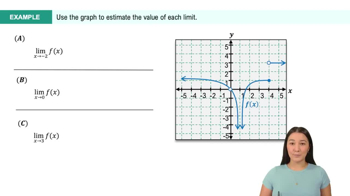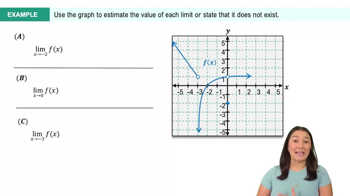Table of contents
- 0. Functions7h 52m
- Introduction to Functions16m
- Piecewise Functions10m
- Properties of Functions9m
- Common Functions1h 8m
- Transformations5m
- Combining Functions27m
- Exponent rules32m
- Exponential Functions28m
- Logarithmic Functions24m
- Properties of Logarithms34m
- Exponential & Logarithmic Equations35m
- Introduction to Trigonometric Functions38m
- Graphs of Trigonometric Functions44m
- Trigonometric Identities47m
- Inverse Trigonometric Functions48m
- 1. Limits and Continuity2h 2m
- 2. Intro to Derivatives1h 33m
- 3. Techniques of Differentiation3h 18m
- 4. Applications of Derivatives2h 38m
- 5. Graphical Applications of Derivatives6h 2m
- 6. Derivatives of Inverse, Exponential, & Logarithmic Functions2h 37m
- 7. Antiderivatives & Indefinite Integrals1h 26m
1. Limits and Continuity
Introduction to Limits
Problem 17d
Textbook Question
Use the graph of f in the figure to find the following values or state that they do not exist. If a limit does not exist, explain why. <IMAGE>
d.
 Verified step by step guidance
Verified step by step guidance1
Identify the behavior of the function \( f(x) \) as \( x \) approaches 1 from both the left and the right.
Examine the graph to determine the value that \( f(x) \) approaches as \( x \to 1^- \) (from the left).
Examine the graph to determine the value that \( f(x) \) approaches as \( x \to 1^+ \) (from the right).
Compare the left-hand limit and the right-hand limit. If they are equal, the limit exists and is equal to that common value.
If the left-hand limit and the right-hand limit are not equal, state that the limit does not exist and explain that the function approaches different values from the left and right.
Recommended similar problem, with video answer:
 Verified Solution
Verified SolutionThis video solution was recommended by our tutors as helpful for the problem above
Video duration:
2mPlay a video:
Was this helpful?
Key Concepts
Here are the essential concepts you must grasp in order to answer the question correctly.
Limits
A limit describes the behavior of a function as its input approaches a certain value. It is essential for understanding continuity and the behavior of functions near points of interest. For example, the limit of f(x) as x approaches 1 examines the values f(x) takes as x gets closer to 1, which can indicate whether f is defined or behaves predictably at that point.
Recommended video:

One-Sided Limits
Continuity
A function is continuous at a point if the limit as x approaches that point equals the function's value at that point. This concept is crucial for determining whether a limit exists. If there is a jump, hole, or asymptote at the point, the limit may not exist, indicating a discontinuity in the function.
Recommended video:

Intro to Continuity
Existence of Limits
The existence of a limit requires that the left-hand limit and right-hand limit at a point are equal. If they differ, the limit does not exist. Understanding this concept is vital for analyzing the graph of f(x) at x = 1, as it helps identify whether the function approaches a specific value from both sides or if there are discrepancies that prevent a limit from being defined.
Recommended video:

Cases Where Limits Do Not Exist

 6:47m
6:47mWatch next
Master Finding Limits Numerically and Graphically with a bite sized video explanation from Callie
Start learning



